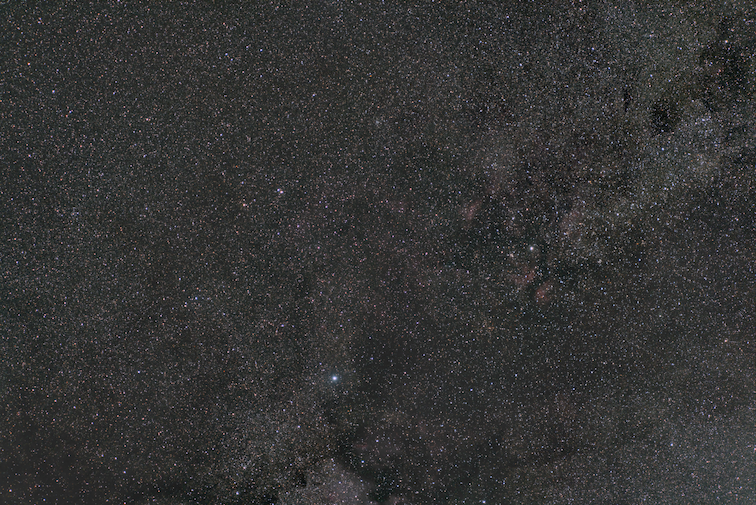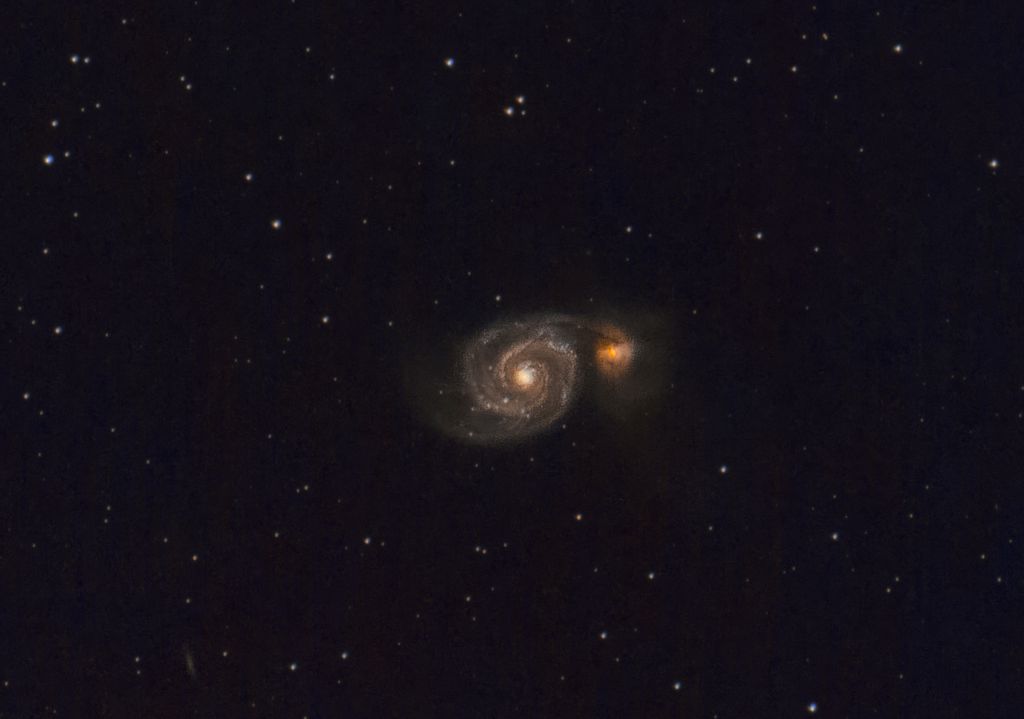Hi everyone! I'm an aspiring Astrophotographer and I have not yet taken a deep sky image. I live in Northern California with Bortle Class 4/5 skies (lightpollutionmap.info says my sky is Bortle Class 5 but it says my neighbor is at Bortle Class 4!)
I have had visual telescopes for some time (Dobsonian, ETX-90) and I am also a keen landscape and wildlife photographer. I am now looking to marry the two hobbies - but I totally understand that Astrophotography is unique.
Last week I got a great deal on a brand new HEQ5 mount. For experimentation purposes I have it mounted to my Meade Tripod with a hacked Azimuth adjuster (the Meade tripod azimuth post doesn't line up with the HEQ5 slot), and I am also using a 3 pound fishing weight zip-tied to the balance rod for counter balance! I have a used HEQ5 tripod and counterweights on order from eBay so the hack is only temporary.
Skies permitting, for the next few nights I plan to test my ability to polar align this thing and also attempt some photographs with my Nikon D750 and Nikkor 105mm lens. I'm curious how long an exposure I can get before I get oblong stars. I know that a 105mm lens is not that challenging - but I'm sure it will be challenging for me.
I'm looking forward to learning from this kind and knowledgable community, and hopefully one day in the future I'll be able to learn enough to make a contribution in return!
Neil
|
You cannot like this item. Reason: "ANONYMOUS".
You cannot remove your like from this item.
Editing a post is only allowed within 24 hours after creating it.
You cannot Like this post because the topic is closed.
Copy the URL below to share a direct link to this post.
This post cannot be edited using the classic forums editor.
To edit this post, please enable the "New forums experience" in your settings.
Welcome to the hobby. You're starting out with a decent quality mount, which is a step up from how most folks start! DSLRs and lenses find their limits quite quickly, but I'd say you're on the right track! If you polar align your HEQ5 well, you should easily be able to do 5 minute exposures at your pixel scale.
Then, capturing data is only half the battle. Processing is where the real fun begins! Good luck!
|
You cannot like this item. Reason: "ANONYMOUS".
You cannot remove your like from this item.
Editing a post is only allowed within 24 hours after creating it.
You cannot Like this post because the topic is closed.
Copy the URL below to share a direct link to this post.
This post cannot be edited using the classic forums editor.
To edit this post, please enable the "New forums experience" in your settings.
Thanks Brian! I was able to get a so-so polar alignment tonight. I took a series of photographs at different exposures and I could start to see oval stars at 3 minutes with a 105mm lens. So I definitely have a lot of work to do on that front. I pointed towards Deneb and Sadr and took twenty 30 second frames at F2.5 and ISO800. (105mm prime lens on Nikon D750.) I took a few darks, flats and bias frames too, and then stacked them in Siril. I have a lot to learn about processing but I was happy to see part of the North America Nebula and a little definition in the Sadr region. This is my first sky image.  (My picture is clearer than this but I'm not sure how to reduce the size for astrobin while preserving definition)  |
You cannot like this item. Reason: "ANONYMOUS".
You cannot remove your like from this item.
Editing a post is only allowed within 24 hours after creating it.
You cannot Like this post because the topic is closed.
Copy the URL below to share a direct link to this post.
This post cannot be edited using the classic forums editor.
To edit this post, please enable the "New forums experience" in your settings.
You cannot like this item. Reason: "ANONYMOUS".
You cannot remove your like from this item.
Editing a post is only allowed within 24 hours after creating it.
You cannot Like this post because the topic is closed.
Copy the URL below to share a direct link to this post.
This post cannot be edited using the classic forums editor.
To edit this post, please enable the "New forums experience" in your settings.
Hi Neil, welcome from Germany! You will rock it!  Clear skies Andreas
|
You cannot like this item. Reason: "ANONYMOUS".
You cannot remove your like from this item.
Editing a post is only allowed within 24 hours after creating it.
You cannot Like this post because the topic is closed.
Copy the URL below to share a direct link to this post.
This post cannot be edited using the classic forums editor.
To edit this post, please enable the "New forums experience" in your settings.
Andreas:
Hi Neil,
welcome from Germany! You will rock it! 
Clear skies
Andreas Vielen Dank, Andreas! In welchen Teil von Deutschland lebst du? Neil
|
You cannot like this item. Reason: "ANONYMOUS".
You cannot remove your like from this item.
Editing a post is only allowed within 24 hours after creating it.
You cannot Like this post because the topic is closed.
Copy the URL below to share a direct link to this post.
This post cannot be edited using the classic forums editor.
To edit this post, please enable the "New forums experience" in your settings.
Hi Neil,
Wolfenbüttel, Niedersachsen. ;-)
Grüße Andreas
|
You cannot like this item. Reason: "ANONYMOUS".
You cannot remove your like from this item.
Editing a post is only allowed within 24 hours after creating it.
You cannot Like this post because the topic is closed.
Copy the URL below to share a direct link to this post.
This post cannot be edited using the classic forums editor.
To edit this post, please enable the "New forums experience" in your settings.
Hi Neil, Welcome to Astrobin. I am also in NorCal, Bay Area mountains. If your DSLR is not astro modded, it will be very hard for it to capture the Ha data for most nebula due to its IR cut filter built-in. the best target now would be the big M31 Andromeda Galaxy, galaxy needs full spectrum capture anyway. Check my take with 135mm camera lens, it would be similar to yours ( https://www.astrobin.com/k3yz1p/). the single sub exposure time does not matter that much but the total exposure time does, so your 30 sec single exposure is fine as long as star is round and sharp. Clear Sky, Oscar
|
You cannot like this item. Reason: "ANONYMOUS".
You cannot remove your like from this item.
Editing a post is only allowed within 24 hours after creating it.
You cannot Like this post because the topic is closed.
Copy the URL below to share a direct link to this post.
This post cannot be edited using the classic forums editor.
To edit this post, please enable the "New forums experience" in your settings.
Oscar Shu:
Hi Neil,
Welcome to Astrobin. I am also in NorCal, Bay Area mountains. If your DSLR is not astro modded, it will be very hard for it to capture the Ha data for most nebula due to its IR cut filter built-in. the best target now would be the big M31 Andromeda Galaxy, galaxy needs full spectrum capture anyway. Check my take with 135mm camera lens, it would be similar to yours (https://www.astrobin.com/k3yz1p/). the single sub exposure time does not matter that much but the total exposure time does, so your 30 sec single exposure is fine as long as star is round and sharp.
Clear Sky,
Oscar Thanks Oscar Wow - I love that Andromeda Galaxy image! No, my camera is not modded. I am still new to this so I need to learn what Ha is, but I am an ex-engineer so I do understand that filtering and capturing different wavelengths will result in different data and resulting images. Sadly for me Andromeda is currently low in the sky in the most light polluted direction - so I may have to wait until it is higher in the sky in the fall. I decided to experiment with the 200-500mm lens that I have and after a lot of setup I was able to capture an image of the whirlpool galaxy. This was also 30s images. It is not a great lens for astro and someone else suggested I stop it down to see if I get sharper stars with less fringing. I have lots of experimentation to do!  Neil
|
You cannot like this item. Reason: "ANONYMOUS".
You cannot remove your like from this item.
Editing a post is only allowed within 24 hours after creating it.
You cannot Like this post because the topic is closed.
Copy the URL below to share a direct link to this post.
This post cannot be edited using the classic forums editor.
To edit this post, please enable the "New forums experience" in your settings.
Andreas:
Hi Neil,
Wolfenbüttel, Niedersachsen. ;-)
Grüße Andreas Wunderbar! Vor mehrere Jahren bin ich 4 Jahre in München gewesen. Gruesse Neil
|
You cannot like this item. Reason: "ANONYMOUS".
You cannot remove your like from this item.
Editing a post is only allowed within 24 hours after creating it.
You cannot Like this post because the topic is closed.
Copy the URL below to share a direct link to this post.
This post cannot be edited using the classic forums editor.
To edit this post, please enable the "New forums experience" in your settings.




